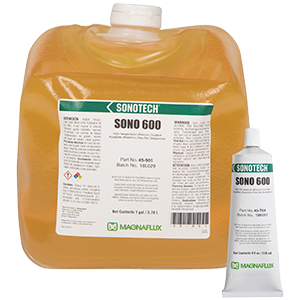Sono 600 is a versatile, multi-purpose couplant with a wide operating temperature range for flaw detection, thickness gauging and acoustic emission testing in petrochemical, power generation, automotive, aerospace, food processing equipment and pharmaceutical manufacturing. Recommended temperature range is 0 to 700°F / -18 to 371°C.
Sono 600 is available in the following sizes:

| Appearance: | Transparent gel |
| Color: | Amber |
| Comparative Viscosity: | 6 - Thick gel |
| Actual Viscosity: | ~500,000 cps (LV #5 @ 1.5 rpm) |
| Long Velocity: | 1.50 cm/sec |
| Impedance: | 1.37 Mrayls |
| Acoustic Performance: | 70 |
| Silicone: | No |
| Glycerin: | No |
| Propylene Glycol: | Yes |
| Water Soluble: | Yes |
| Halogens: | < 50 ppm |
| Sulfur: | < 50 ppm |
| Flash Point*: | 439°F (226°C) |
| Auto-Ignition Temperature†: | 788°F (420°C) |
| Temperature Range‡: | 0° to 788°F (-18° to 371°C) |
| Storage Temperature: | 50° to 86°F (10° to 30°C) |
| Compatibility: | Most composites and metals |
* Flash point temperature determined in accordance with ASTM Method D92 using the Cleveland Open Cup method. In areas where vapors may be confined in an enclosed or semi-enclosed area, the actual flash point of this product may be lower than recorded.
† Auto-ignition temperature determined in accordance with ASTM Method E659.
‡ Recommended temperature based on Flash Point and Auto Ignition Temperature. In areas where flame or other ignition source may be present, or in applications where vapors may be confined in an enclosed or semi-enclosed area, these products should not be used above the flash point temperature.
In most applications, the transducer is best coupled with the thinnest layer of couplant possible. Apply a small bead of couplant directly to the center of the transducer face and push the transducer down onto the test surface with a uniform force so the couplant spreads out evenly towards the edge of the transducer.
In high-temperature applications it is recommended that extra care is taken to use just enough couplant to perform the test procedure as excess couplant may increase vapors which can pose a flash hazard.
Remove excess couplant from transducers and other surfaces by wiping with disposable rags or paper towels, being careful to protect skin from hot surfaces.
Do not use solvent-based cleaners on hot surfaces.
Store couplant in the original container. Do not freeze. Store out of direct sunlight. Keep container closed when not in use. Never put unused
couplant back into the original storage container.
The 4 oz tubes have been discontinued